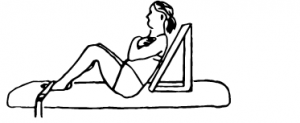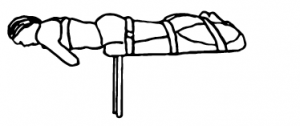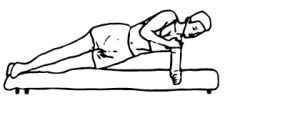Purpose of test:
To assess muscle endurance of the torso stabiliser muscles
Test procedure:
The protocol consists of four tests that measure all aspects of torso strength via isometric
muscle endurance.
1.Trunk flexor test (TFT)
• The TFT is used to assess the endurance of the anterior musculature of the core (rectus abdominis) (Brumitt, 2010).
• ‘The flexor endurance test begins with the person in a sit-up position with the back resting against a jig angled at 60 degrees from the floor. Both knees and hips are flexed 90 degrees, the arms are folded across the chest with the hands placed on the opposite shoulder, and the feet are secured. To begin, the jig is pulled back 10 cm, and the person holds the isometric posture as long as possible. Failure is determined when any part of the person’s back touches the jig.’ (Nesser et al., 2008).
• Record how long in seconds the client is able to maintain the position (Brumitt, 2010; Nesser et al., 2008).

2.Trunk extensor test (TET) (Note: this test can be used as a separate outcome measure; see Back Extension Test for reliability and validity for this test)
• The TET is used to assess the erector spinae and the multifidis (Brumitt, 2010).
• The clinician stands to the side of the client’s torso to ensure correct alignment (Brumitt, 2010).
• ‘The back extensors are tested with the upper body cantilevered out over the end of the test bench and with the pelvis, knees, and hips secured. The upper limbs are held across the chest with the hands resting on the opposite shoulders. Failure occurs when the upper body drops below the horizontal position.’ (Nesser et al., 2008)

3. Le” lateral musculature test and right lateral musculature test
• The lateral musculature tests (LMT) are used to assess the obliques, transverse abdominals and quadratus lumborum (Brumitt, 2010).
• The following protocol is for both the le! and right lateral musculature tests: ‘The lateral musculature is tested with the person lying in the full side-bridge position (le” and right side individually). Legs are extended, and the top foot is placed in front of the lower foot for support. Clients support themselves on one elbow and on their feet while li”ing their hips o! the floor to create a straight line from head to toe. The uninvolved arm is held across the chest with the hand placed on the opposite shoulder. Failure occurs when the person loses the straight-back posture and/or the hips return to the ground.’ (Nesser et al., 2008).
• If the client is unable to assume the correct position, a gross weakness in the lateral core muscles is evident (Brumitt, 2010).
• Ensure that the client remains in the correct posture for the duration of the test (Brumitt, 2010).

Record the total time that each isometric position can be held, allowing a minimum of 5 minutes rest between each test (Nesser et al., 2008).
Brumitt, J. (2010). Core assessment and training. Australia: Human Kinetics.